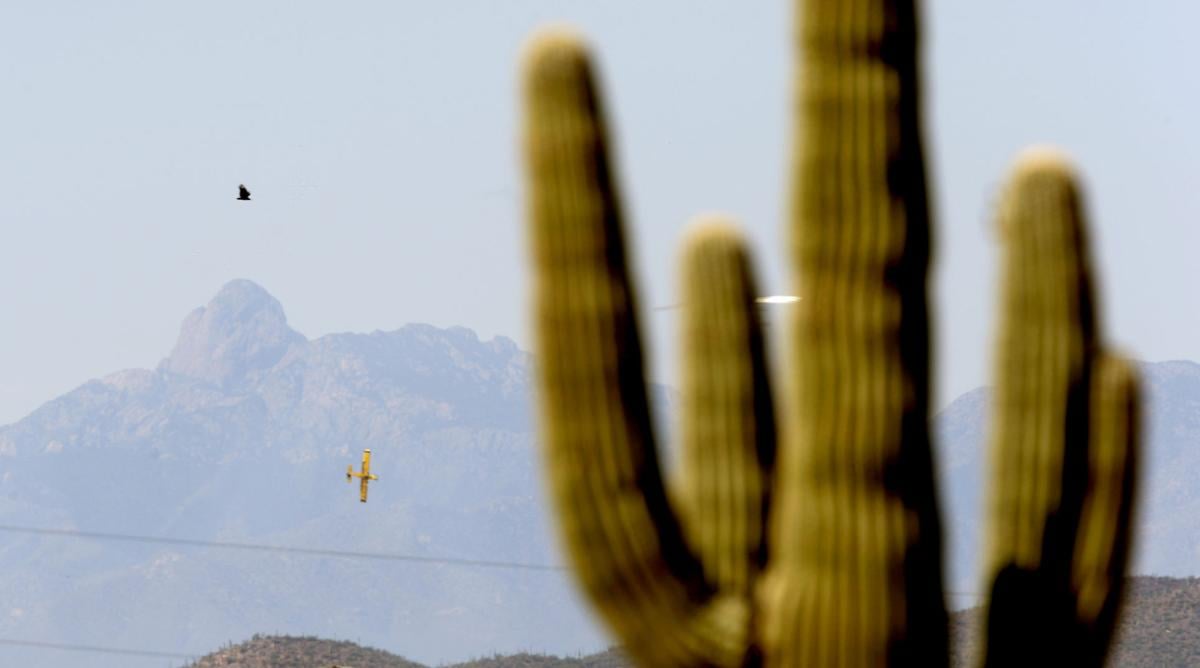Saguaro National Park, long known for its vast expanses of lush desert and stately cacti, has now made it onto a list of most polluted national parks.
Largely because of haze that obscures long-distance views, the park ranks 12th-worst in a study done by a national environmental group. The research findings were generally backed up by the National Park Service, which runs Saguaro and other parks.
Saguaro fared a notch better than 11th-ranked Great Smoky Mountains National Park, which has struggled with serious air pollution for decades. The most-polluted park ranking was shared by the adjacent Sequoia and Kings Canyon national parks in California’s Sierra Nevada Mountains. Grand Canyon National Park ranked 17th-worst, and Chiricahua National Monument was 20th.
The study, released last week, looked at 48 national parks that come under federal Clean Air Act protection. It was done by the National Parks and Conservation Association.
Saguaro Park got a D grade for its obscured distant views. Air monitoring data showed that people standing in Saguaro Park-West and East can typically see nowhere near as far as they could if the air were clearer under natural conditions.
The park also scored Cs for healthy air and climate change impacts from greenhouse gases, said the study.
“We don’t think of our area as being particularly polluted, but there are things polluting the air in our park,” said Kevin Dahl, the conservation association’s Arizona program manager. “Many national parks were selected as special places where we want to achieve clean air. Because of haze-causing and health-damaging pollution from coal-fired power plants, automobiles, and drought-induced dust storms, we’re a long ways from achieving this important goal at Saguaro National Park.”
National Park Service officials generally agree with the conservation group’s findings about air quality in the park, said Darla Sidles, Saguaro Park’s superintendent.
“The Clean Air Act is working and air quality is improving, but more needs to be done, because air pollution impacts all our parks,” Sidles said.
On an average day, someone should be able to see as far as 161 miles from Saguaro Park’s western unit and 162 miles from its eastern unit, said the conservation group.
But because of the haze, typically someone can see barely half that — 83 miles — from Saguaro-West and 96 miles from Saguaro-East, for a parkwide average of 89 miles, the study found.
The figures came from the group’s analysis of air quality data recorded by an interagency monitoring network that has stations at both park units.
Park Service officials believe the conservation association probably calculated the view ranges correctly, a service official said. “We’re fine with the numbers,” said Patricia Brewer, a park service environmental protection specialist in Denver.
Naturally occurring dust from soil and human-caused sulfates and nitrates are all key sources of the haze at both Saguaro Park units, Brewer said. In the winter, the biggest man-made pollutant sources are ammonium nitrate compounds — formed by the reaction of nitrogen oxides from cars and power plants with ammonia from animal waste and other agricultural uses, she said.
Summertime haze is more likely to come from sulfates, formed by combustion of fossil fuels at power plants and copper smelters, said Brewer. Particulates from wildfires also cause hazy skies, she said.
The C grade for healthy air stems largely from ozone compounds that are persistently in the air at levels close to federal air quality standards, said the park service’s Sidles.
As for climate change, “We can say with relative confidence it is getting hotter and drier,” which increases the presence of invasive species, particularly buffelgrass, Sidles said. That will fuel more fires, and the park’s signature saguaros are likely to move uphill as the air warms.
“We have no idea if there are going to be fewer or more saguaros,” she said. “We’ve been doing studies on that and they’re inconclusive. We know invasive grasses are on the rise everywhere, and in the park as well.”
Legally, Congress has set a goal of having no human-caused impairment of visibility in any national parks and monuments and wilderness areas by 2064.
“Clearly, we know that the parks are not making progress called for to reach natural conditions” by then, Brewer said.
The new study concluded that in 50 years, if federal rules regulating hazy skies aren’t tightened up, only 10 percent of the national parks covered by the rules will reach the federal goal. Saguaro Park is 600 years away from reaching it at the current pace of cleanup, said Ulla Reeves, clean air campaign manager for the National Parks and Conservation Association.
“We are not on track — a park like Saguaro is clearly very, very far off-track,” Reeves said.
The Arizona Department of Environmental Quality, which regulates air quality in the state, is more optimistic.
In preparing a statewide air cleanup plan two years ago, the state demonstrated that while visbility in the park is impaired, it’s improving “at a reasonable rate of progress toward the goal of natural conditions by 2064,” the department said in a statement last week.
While continued population growth means more vehicle emissions, the good news is that the Environmental Protection Agency, the state of California and auto manufacturers have agreed on more stringent emission limits from new vehicles, the department said.
Coupled with stricter fuel economy standards, that should ensure continued improvement in views near major population centers such as Tucson and Phoenix, said Caroline Oppelman, ADEQ’s spokeswoman.





